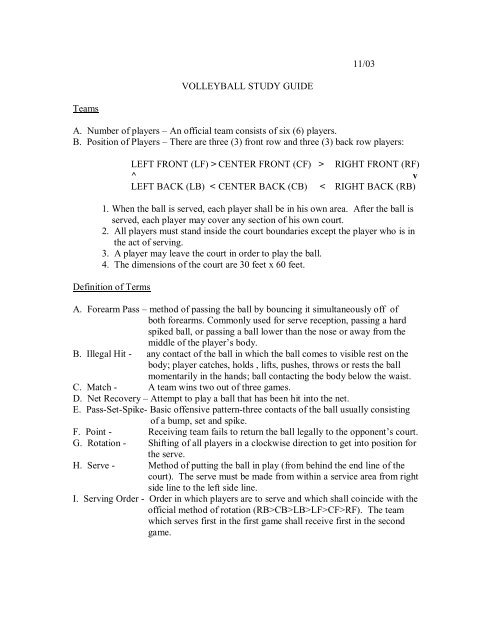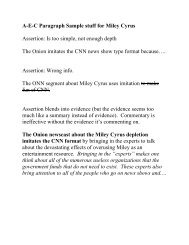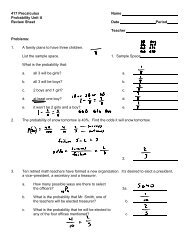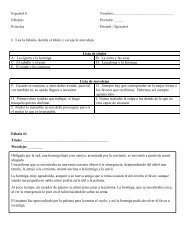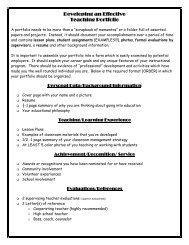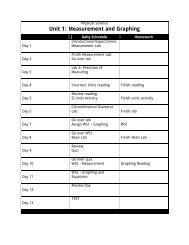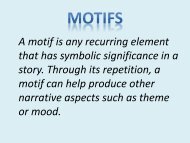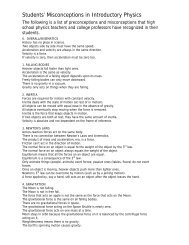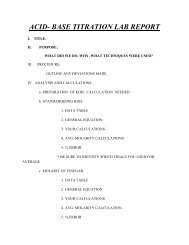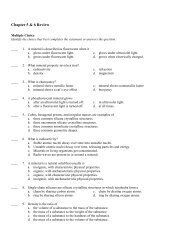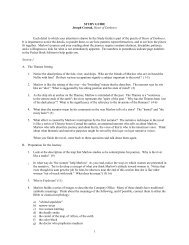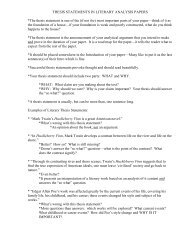11/03 VOLLEYBALL STUDY GUIDE Teams A. Number of players ...
11/03 VOLLEYBALL STUDY GUIDE Teams A. Number of players ...
11/03 VOLLEYBALL STUDY GUIDE Teams A. Number of players ...
You also want an ePaper? Increase the reach of your titles
YUMPU automatically turns print PDFs into web optimized ePapers that Google loves.
<strong>11</strong>/<strong>03</strong><strong>VOLLEYBALL</strong> <strong>STUDY</strong> <strong>GUIDE</strong><strong>Teams</strong>A. <strong>Number</strong> <strong>of</strong> <strong>players</strong> – An <strong>of</strong>ficial team consists <strong>of</strong> six (6) <strong>players</strong>.B. Position <strong>of</strong> Players – There are three (3) front row and three (3) back row <strong>players</strong>:LEFT FRONT (LF) > CENTER FRONT (CF) > RIGHT FRONT (RF)^vLEFT BACK (LB) < CENTER BACK (CB) < RIGHT BACK (RB)1. When the ball is served, each player shall be in his own area. After the ball isserved, each player may cover any section <strong>of</strong> his own court.2. All <strong>players</strong> must stand inside the court boundaries except the player who is inthe act <strong>of</strong> serving.3. A player may leave the court in order to play the ball.4. The dimensions <strong>of</strong> the court are 30 feet x 60 feet.Definition <strong>of</strong> TermsA. Forearm Pass – method <strong>of</strong> passing the ball by bouncing it simultaneously <strong>of</strong>f <strong>of</strong>both forearms. Commonly used for serve reception, passing a hardspiked ball, or passing a ball lower than the nose or away from themiddle <strong>of</strong> the player’s body.B. Illegal Hit - any contact <strong>of</strong> the ball in which the ball comes to visible rest on thebody; player catches, holds , lifts, pushes, throws or rests the ballmomentarily in the hands; ball contacting the body below the waist.C. Match - A team wins two out <strong>of</strong> three games.D. Net Recovery – Attempt to play a ball that has been hit into the net.E. Pass-Set-Spike- Basic <strong>of</strong>fensive pattern-three contacts <strong>of</strong> the ball usually consisting<strong>of</strong> a bump, set and spike.F. Point - Receiving team fails to return the ball legally to the opponent’s court.G. Rotation - Shifting <strong>of</strong> all <strong>players</strong> in a clockwise direction to get into position forthe serve.H. Serve - Method <strong>of</strong> putting the ball in play (from behind the end line <strong>of</strong> thecourt). The serve must be made from within a service area from rightside line to the left side line.I. Serving Order - Order in which <strong>players</strong> are to serve and which shall coincide with the<strong>of</strong>ficial method <strong>of</strong> rotation (RB>CB>LB>LF>CF>RF). The teamwhich serves first in the first game shall receive first in the secondgame.
-2-J. Set - Overhand technique <strong>of</strong> putting the ball into the air close to the net forthe spike.K. Side out - The serving team fails to win the point. The serving team receives apoint and the next serve.L. Spike - Striking <strong>of</strong> the ball with the hand above net height to send the ballforcefully downward into the opponent’s court.Playing the GameA. Choice <strong>of</strong> 1 st serve –is determined by a coin toss.B. The game – a game is complete when a team scores a total <strong>of</strong> 25 points. The winningteam must have at least a 2 point advantage. If a team is not ahead when25 points have been scored, play continues until one team is ahead by 2.C. Rally Scoring – During the course <strong>of</strong> play, both teams are eligible to score points.D. Ball put in play-At the opening <strong>of</strong> the game, the ball shall be put in play by the playerin the right back (RB) position from within the serving area.E. Rotation- The team receiving the ball for service shall immediately rotate positions asindicated in the diagram on the first page.F. Legal serve- The server may:1. Hit the ball directly <strong>of</strong>f the holding hand.2. Hit the ball after tossing it directly upward from the holding hand.3. Hit the ball with only one hand, open or closed.4. Hit the ball with the forearm.5. Step on or over the end line after the ball has been hit.6. A serve that hits the net and goes over is a legal serve.G. Three volleys by a team-The ball may be volleyed only three times before it is sentover the net.H. Simultaneous contact1. If two or more <strong>players</strong> <strong>of</strong> the same team contact the ball simultaneously, it isconsidered one hit and <strong>players</strong> involved may participate in the next play.This next play should be counted as an additional volley.2. If two or more <strong>players</strong> from opposing teams contact the ball simultaneouslyabove the net, this simultaneous contact shall not be considered as one <strong>of</strong> thethree volleys allowed a team; the first <strong>players</strong> involved are eligible toparticipate in the next play which shall be considered the first <strong>of</strong> three volleysallowed to the team.I. Ball crossing the net1. Some part <strong>of</strong> the ball must pass over either one <strong>of</strong> the markers on the net orwithin the two markers.2. A ball striking the net and going over is still in play.3. The ball may be played when any part <strong>of</strong> it has crossed the top <strong>of</strong> the net.
It is not essential for the entire ball to be on the player’s side <strong>of</strong> the net beforeit is played.-3-J. Recovery from the net. A ball may be recovered from the net, provided the playeravoids touching the net.K. Ball touching a boundary line A ball touching a boundary line is good.L. Change <strong>of</strong> courts At the end <strong>of</strong> each game <strong>of</strong> the same match, teams shallchange courts.M. Changing positions At the beginning <strong>of</strong> a new game, the <strong>players</strong> may be rearrangedin their positions.N. Serving order <strong>Teams</strong> alternate serving at the beginning <strong>of</strong> each new game.Point, Side Out and Double FoulPointIf any player from either team commits any <strong>of</strong> the following acts, one point shallshall be scored. If the serving team scores they retain the serve. If the receivingteam scores they also receive the serve (side out).A.B.C.Serves the ball illegally1. Ball is not definitely hit.2. Ball goes into the net.3. Ball fails to reach the net.4. Ball strikes an object directly over the court.5. Serve is assisted by another player.6. Server commits a foot fault.Plays the ball illegally1. Fails to return the ball legally to opponents’ court.2. Catches or holds the ball. A player may not, either on or <strong>of</strong>f the court,catch or touch the ball and call it out.3. Plays the ball more than once in succession.4. Volleys the ball a fourth time.5. Illegal contact.6. Back row player returns a ball which is completely above the net from aposition on or in the front <strong>of</strong> the 10 foot line.7. Blocking and/or attacking a serve is not permitted.1. Holds or pushes the ball against the net.Plays illegally at net2. Touches the net with any part <strong>of</strong> the body while the ball is in play.3. Reaches over the net to play a ball completely on the other side <strong>of</strong> the netexcept to block.4. Reaches under the net in such a way as to cause interference with play onthe opposite court.5. A back court player may not attempt to play the ball above the net.
-4-D. Double Foul.A double foul shall be called when <strong>players</strong> <strong>of</strong> opposing teamscommit a foul at the same time. If this should occur, the playshall be repeated.E. Foot fault.1. On the serve, both feet must remain completely behind the endline until theball is contacted.2. A player may not step completely over the center line.Forearm Pass– used to pass the ball to the setter when receiving the serve or whenplaying any ball below the waist.A. Body Positioning1. Back remains straight.2. Hands clasped together, arms straight and away from the body.3. Feet are shoulder width apart.4. The body should face the intended direction <strong>of</strong> the pass.B. Ball contact.1. The contacts the “meaty” surface <strong>of</strong> the forearms between the wrist and elbow.2. Arms are level and contact the ball simultaneously.3. Arms should not swing above shoulder level.C. Most common faults.1. The ball is contacted on the clasped hands instead <strong>of</strong> the forearms.2. Standing too upright; standing flat-footed.3. Standing in a parallel stance, not allowing quick forward, backward andlateral movement.4. Forearms not close together; forearms not parallel with thighs; arm positioningeither too high or too low, causing poor or impossible trajectory.5. The wrists not rotated far enough outward, causing the ball to be played <strong>of</strong>f <strong>of</strong>the bone <strong>of</strong> the forearm.6. Striking at the ball with the forearms, causing to much acceleration and notenough absorption.7. Hands not clasped together.8. Tenseness9. Forearms flexed instead <strong>of</strong> straight; not watching the ball contact the forearms.10. Failure to move to play the ball between the legs as <strong>of</strong>ten as possible.<strong>11</strong>. No use <strong>of</strong> the lower body (thighs and lower leg) for acceleration <strong>of</strong> the ball.12. No follow through for ultimate length <strong>of</strong> ball contact and control.
SettingSpike-5-– the purpose <strong>of</strong> the set is to receive the serve and/or precisely set the ball to aspiker. The ball is set using both hands above the forehead.A. Body positioning1. Setter must move to get his body directly under the ball.2. Hands are above the forehead prior to contact with the ball.3. The body faces the direction the ball is about to be set.B. Ball contact1. Ball is contacted directly in front <strong>of</strong> the forehead.2. Fingers are relaxed for absorption.3. The thumbs, index fingers and forefingers are the main contactingareas on the ball.– a method <strong>of</strong> forcefully hitting the ball in a downward direction.A. Hand contact and arm action.1. Contact with the ball should be made with an open, relaxed hand ata point 6 – 18 inches in front <strong>of</strong> the spiking shoulder.2. Arm action prior to contact resembles an outfielder’s throw in baseball.3. When spiking, accuracy and placement should never be sacrificedfor power.Overhead Serve – the purpose <strong>of</strong> the serve is to put the opponents on the defensive and toscore points as a direct result <strong>of</strong> its effectiveness.A. Body Position1. Body faces the net with the shoulders parallel to the net and end line.2. Feet are in either a parallel or slightly staggered stance.3. Knees are flexed for comfort and relaxation.B. Ball toss, arm action1. Ball is held with both hands. It is held straight-armed at eye level withthe server using extreme concentration prior to starting the action. Thestriking hand is on top <strong>of</strong> the ball with the other hand under the ball forsupport and balance.2. Ball is tossed 2 -3 feet above the head and about 1 ½ feet forward <strong>of</strong> theshoulder <strong>of</strong> the striking hand.3. The body weight transfers from the back foot to the front foot.4. Action <strong>of</strong> the striking arm resembles a baseball throw.


